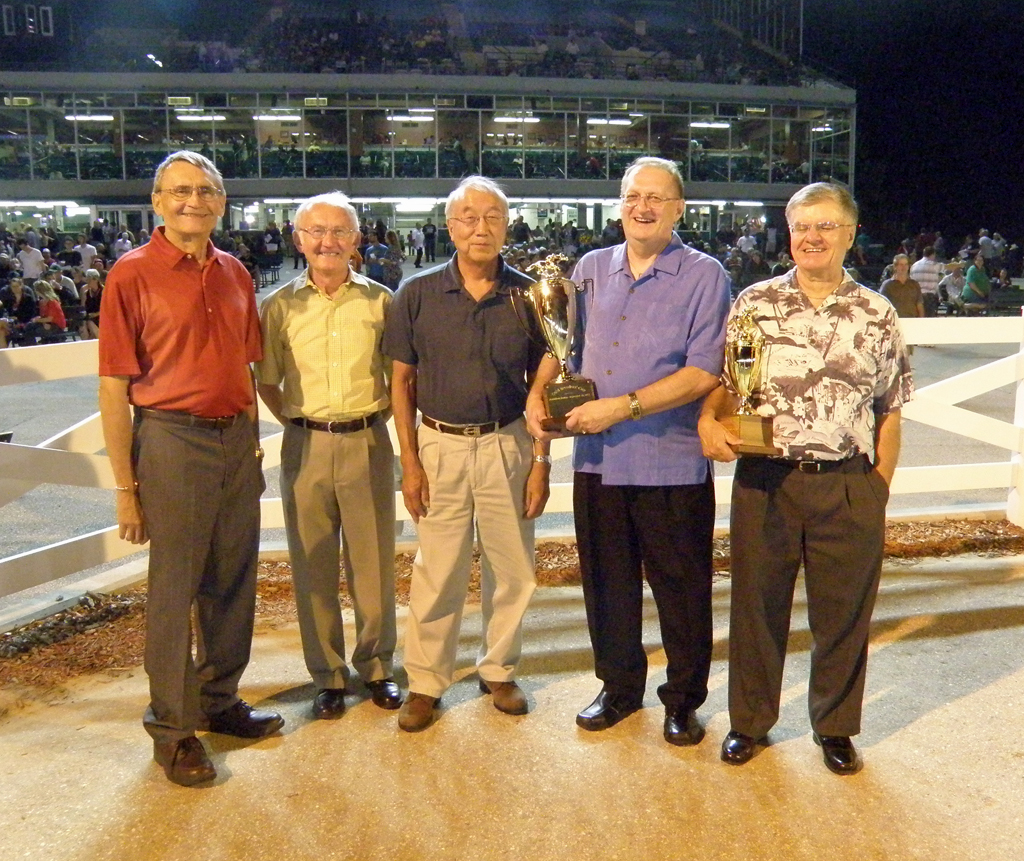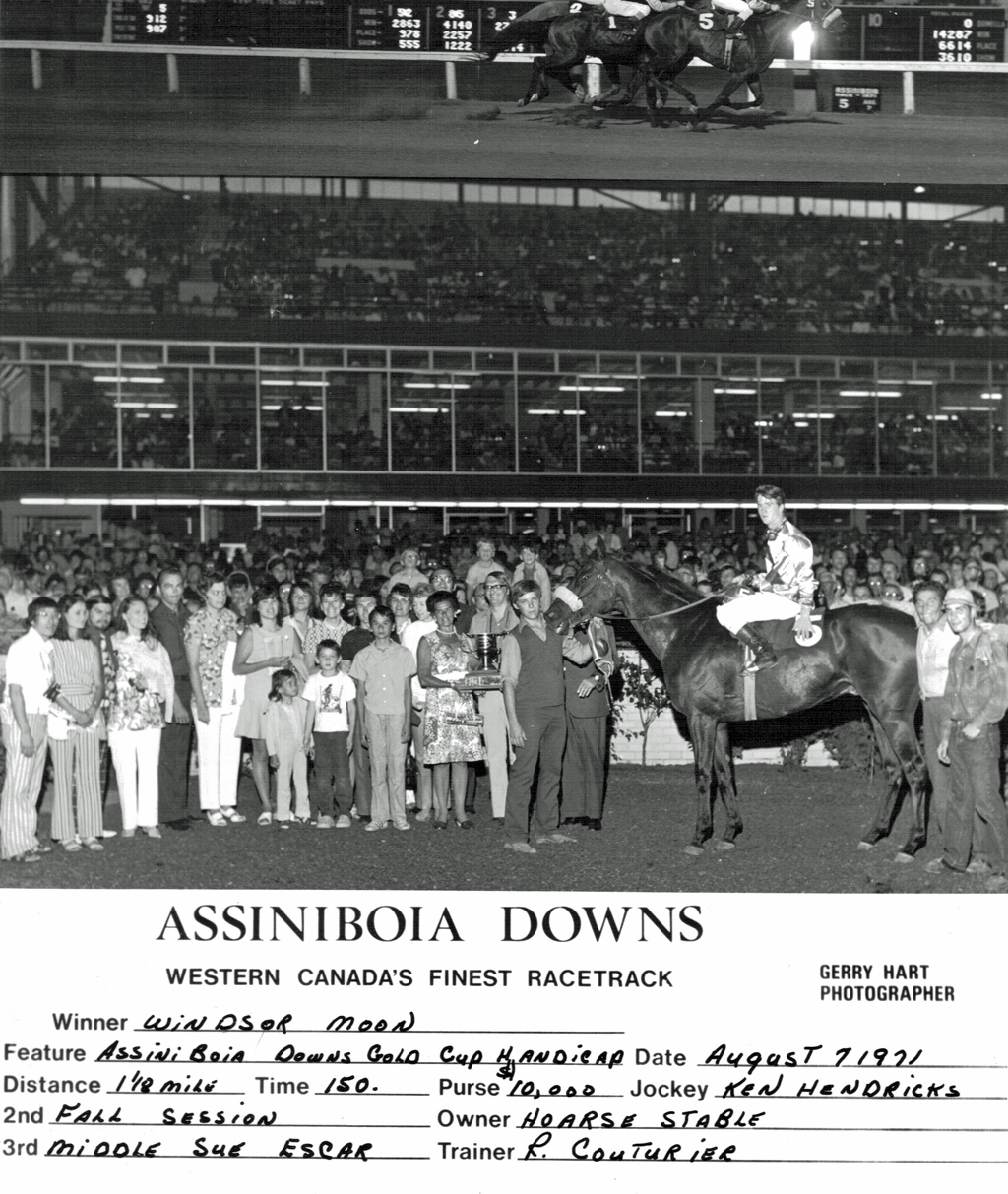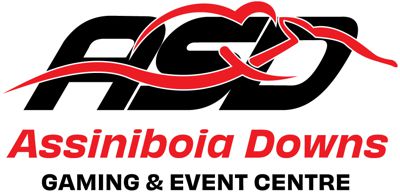
by Bob Gates
What do you get when you combine seven St. Boniface school teachers, $1,500 and a desire for fun and adventure? Back in May 1970 you’d get Hoarse Stable and a four-year-old thoroughbred called Windsor Moon.
Who remembers him?
This dark bay gelding was the shiny apple these teachers always wanted. Not sitting on their desks of course, but in their barn at Assiniboia Downs. Windsor Moon was no ordinary B.C. Macintosh. In Windsor Moon the group saw something special. Was it his personality? His pedigree?
All that and more.
Hoarse Stable was comprised of Ron Bernaerdt, Ray Friesen, Verne Kozar, Don Kyliuk, Moe Oye, John Parker and Keith Radford. Now that they had a horse, a trainer, Romeo Couturier and Romeo’s jockey of choice, Joseph Selyem — it was post time!

2011 Gold Cup. Hoarse Stable: Don Kyliuk, Keith Radford, Moe Oye, Ron Bernaerdt and Verne Kozar. Memories!
They didn’t have to wait long for success. In June 1970, in his first start for the newly formed stable, “Moon” delivered his signature last-to-first move, coming from the clouds as the longest shot on the board to nip favourite Mr. Chinapin at the wire. In his racing debut for his new owners the teachers all but recouped their investment from their wagers. That’s what happens when your horse pays $82.20 for a $2-win ticket.
The 1970 racing season was a successful one for the group, but there was one minor speed-bump on the road to success. It came in August when they lost Moon via a $2,500 claim made by his breeder. Even though the stable made a $1,000 profit off the claim, they knew they had something special and quickly repurchased the gelding for $4,000.
Not many realize that Windsor Moon shared some ancestry with the mighty Secretariat. The 1973 Triple Crown Winner’s mom, Somethingroyal had Princequillo as her sire and Windsor Moon’s dad, Royal Gossip had Princequillo as his sire. So there was some champion genes in his lineage.
The group finished out 1970 running Moon another handful of times, both at the Downs and down east at Woodbine and Blue Bonnets. Only now there would be no more claiming races for the dark bay.
Hoarse Stable and Windsor Moon were back at the Downs for the 1971 racing season and pretty much picked up where the 1970 season left off. After finishing out of the money in his first race of the year, which was a sprint, against tough company, the group found a nice two-turn allowance race for his second start.

The June 5 race was a good one for Moon. The 7-furlong distance was more to his liking and suited his come from deep closing style. His win in this allowance race was his sixth since the teachers claimed him in May 1970. His win prices for those wins included four where he paid more than $20:
- – June 29,1970 – $82.20 (Assiniboia Downs)
- – August 6, 1970 – $21.20 (Assiniboia Downs)
- – September 20, 1970 – $29.10 (Woodbine)
- – June 5, 1971- $27.50 (Assiniboia Downs)
It was during this win streak that Hoarse Stable made a strong case for the Winner’s Circle to be enlarged. With each win more and more people crowded together for the win photo to celebrate Windsor Moon’s latest feat.
Like any athlete, Windsor Moon had his good and bad days. He was an up and down kind of runner. He wasn’t always the soundest of horses and when he was good, he was very good. When he was bad, he could be awful.
In July 1971 he developed ankle issues and it looked like he was going to be laid up for the rest of the year. He rebounded however, like the stakes winner he could be. Moon was showing flashes of his old self as he prepared for the biggest challenge, the 1971 Gold Cup.
On Saturday August 7, 1971 Windsor Moon faced his toughest competition yet in the 1 1/8-mile, $10,000 Added Assiniboia Downs Gold Cup. Sadly, Windsor Moon had to race without his loyal friend and regular rider, Joseph Selyem. Selyem was on the mend due to injuries he suffered in a riding accident just a couple of weeks earlier. But Joseph’s bad luck was rookie Ken Hendricks’ good fortune. Up and comer “Hank” Hendricks was in his third year of riding and got the mount in what was the biggest race of his young life.
The field for the Gold Cup was small. Only six combatants went to post. Windsor Moon was the longest shot on the board at 13 to 1. The balance of the entrants ranged in odds from 8/5 to 3/1. With the exception of Moon, the contestants were that evenly matched.
As for the running of the race itself, there was no better source of information than Hendricks himself. Hank isn’t going to like this, but it has been nearly 50 years since that Gold Cup was run. Hey, who among us likes being reminded that we’re getting old, but his memory of the race was as sharp as if it was run yesterday. When you consider how many thousands of mounts he had over the course of his career, this race had to be something special.
He recalled a Windsor Moon that wasn’t aging all that well. He could run yes, but he also had the aches and pains of a horse twice his age. In 1971 Windsor Moon was a 5-year-old, but he had his issues and the summer of ‘71 was a tough one for the teachers’ pet.
Hendricks remembered that Jimmy Anderson was on the favourite, Fall Session, another good off-the-pace horse. As they passed the grandstand for the first time, Fall Session and Windsor Moon battled it out for last place. When they hit the backside, Ken described the race as follows:
“There was the field, five lengths off them was Fall Session and about six or eight lengths behind him was me. I thought I was going to be out-distanced.”
He said that he was so far back that he really didn’t believe he had a chance to win!
“I started closing a little on him and then Fall Session just blew by everyone and made the lead early in the stretch. At the head of the lane, I was hoping I could be third. Half way down the lane I thought, wow, I could be second. About 100 yards from the wire I was gaining so fast that I thought I might be able to win!
“It looked to me like Fall Session was hanging a little and my horse was drifting in a little at the wire, but I got up for the win! I think Jimmy was kind of sleeping a little too or he may have been a little preoccupied with Middle Sue Escar who was close and on his inside.
“Jimmy took a shot and claimed foul. He later told me that he knew it wouldn’t stand, but he scared the living crap out of me! After the race, Jimmy laughed because I was so scared about the inquiry.
“It’s a big rush to come from that far back though. It was a big thrill for me. I was just a dumb kid. It’s rare that you come from that far out of it to win.”
This race was a huge deal for Hendricks. The 1971 Gold Cup was the richest handicap of the meet. In addition, history would go on to record that Hendricks would win a record-setting seven Gold Cup races in his 41-year riding career and it all started with Windsor Moon.

Moon never quite got his stride back in 1972. He failed to hit the board in six starts. In 1973 the teachers dropped him into some cheaper claiming races, but the Moon’s glory years were behind him. He won but one of his thirteen starts that year. In 1974 he was winless in his twelve races. In 1975 he won just one of his five starts. The 1971 Gold Cup winner just wasn’t his old self. He had some health issues which he was always able to overcome, but age was against him.
In 1976 a twisted bowel would see him take his last breath.
The game gelding gave his all for a group of teachers who only wanted to have a little fun. Instead, they ended up with a stakes-winning gentleman racehorse. Windsor Moon was a fierce competitor on track, yet as gentle as a lamb around children. The gelded grandson of Princequillo gave so much of himself he forever earned the title of “Teachers’ Pet.”
In 2011, five of the teachers gathered together on familiar ground, the winner’s circle at Assiniboia Downs, to present the Gold Cup to Big Blue Caboose, on the anniversary of their own Gold Cup win 40 years earlier.
Together, one last time, they celebrated and fondly remembered their “Teachers’ Pet”, their old friend…
Windsor Moon.
